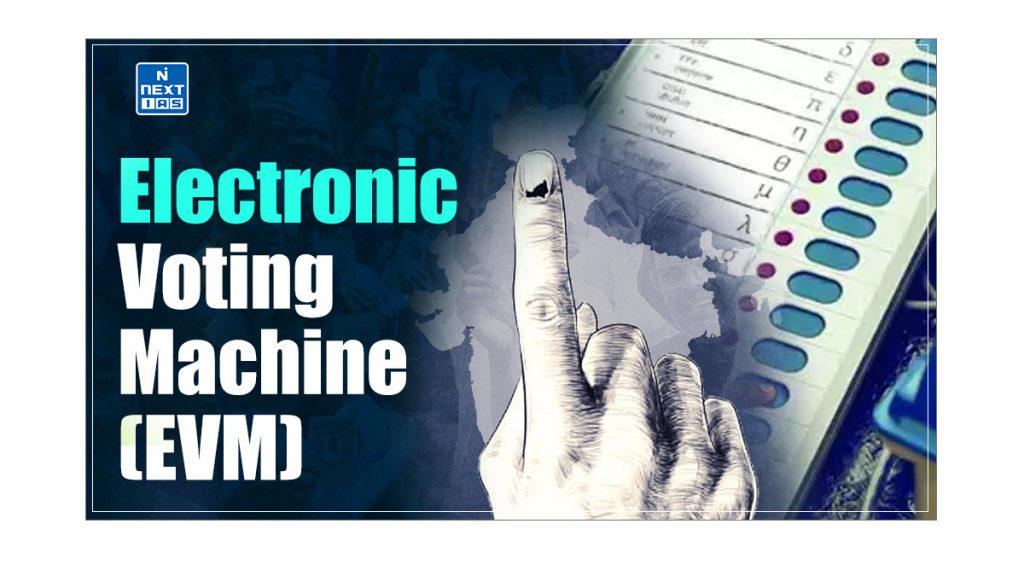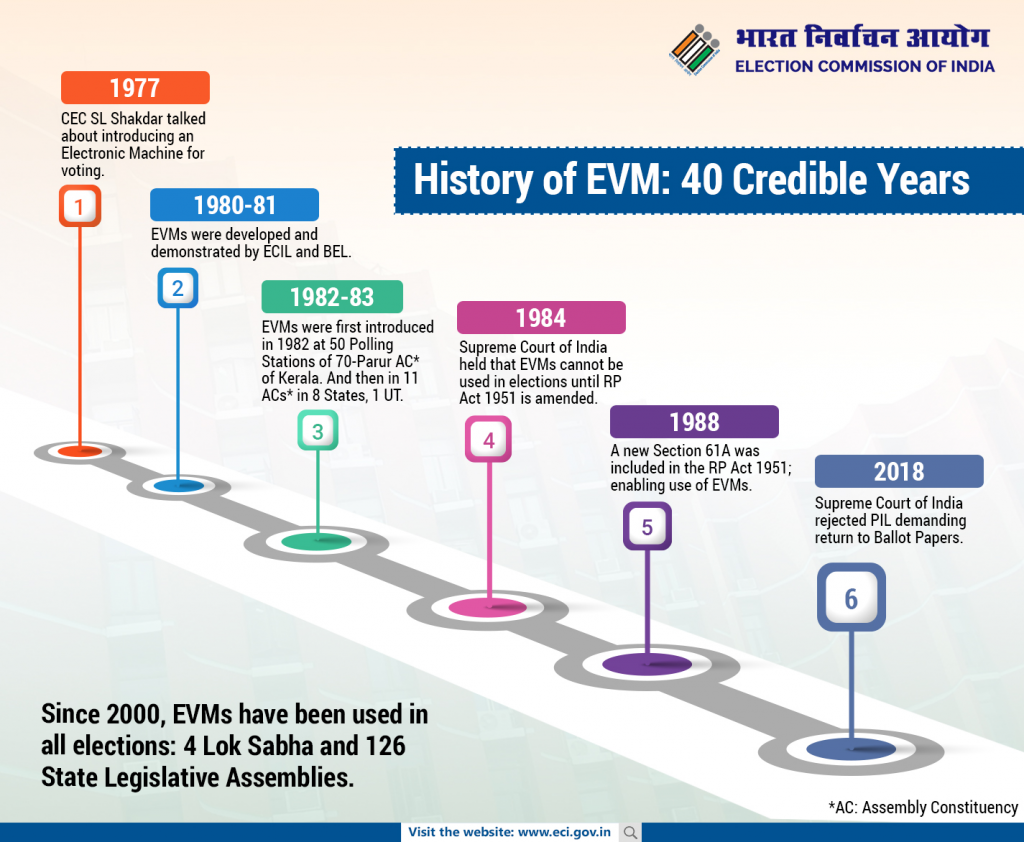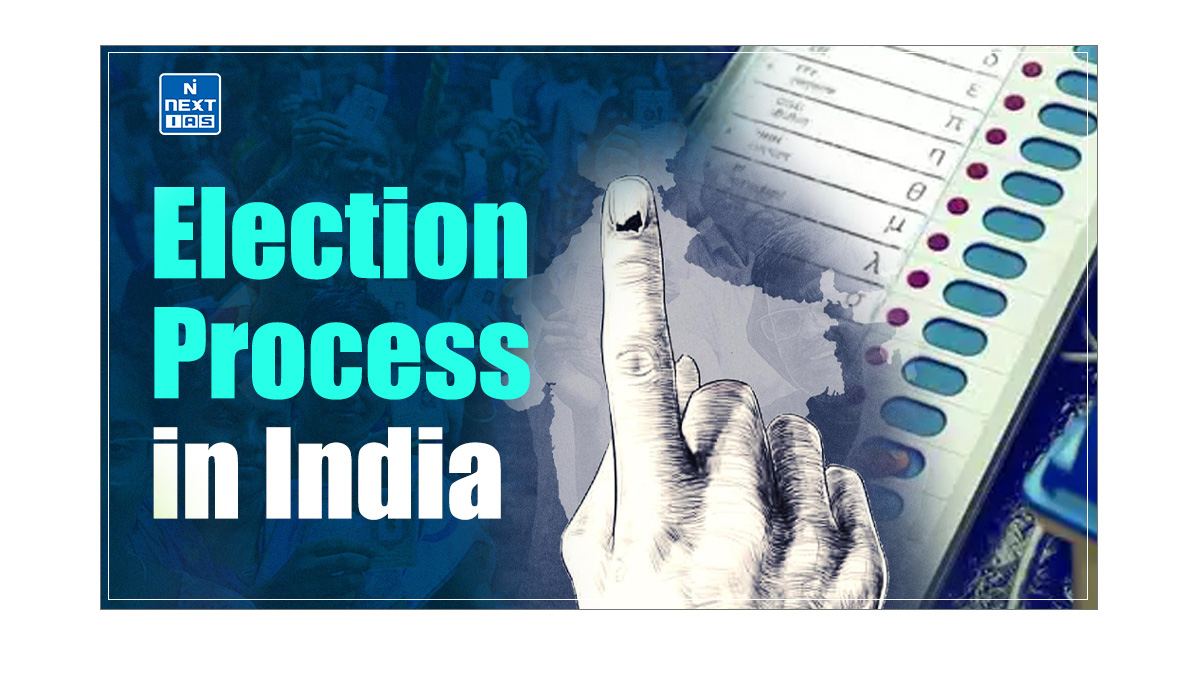
Electronic Voting Machines (EVMs) have become an integral part of the modern electoral process in India. Designed to enhance efficiency, accuracy, and security, these advanced voting systems aim to streamline the casting and tallying of votes, moving away from traditional paper-based ballots. This article of NEXT IAS aims to study in detail the Electronic Voting Machines (EVMs), their key features, evolution, functionalities, benefits, challenges and other related aspects.
What is Electronic Voting Machine (EVM)?
- An Electronic Voting Machine (EVM) is a portable electronic instrument for the purpose of conducting elections to the Parliament, State Legislature and Local bodies like Panchayats and Municipalities.
- It enables voters to cast their votes using an electronic machine, thus replacing the traditional method of voting using paper ballots.
Features of Electronic Voting Machine
The Electronic Voting Machines (EVMs) used in India have the following key features:
- Voting Capacity– EVMs are designed to record a maximum of 2,000 votes, ensuring efficient and reliable performance during elections.
- Tamper-Evident Design– The EVMs are designed with tamper-evident features, such as seals and security codes, to ensure that any attempts to manipulate the machines can be easily detected.
- Secure Data Storage– The votes cast are stored in the EVM’s memory in an encrypted format, ensuring the confidentiality and integrity of the data.
- Backup Power– EVMs are powered by alkaline batteries, making them portable and suitable for use in a variety of locations, including remote or rural areas where access to electricity may be limited.
- Instant Vote Counting– The votes stored in the EVM’s memory can be quickly tallied, providing instant and accurate results, unlike manual counting of paper ballots.
- Portability and Mobility– EVMs are lightweight and portable, making it easier to transport them to polling stations and conduct elections in remote areas.
- Multilingual Support– EVMs can display ballot options in multiple languages, catering to the diverse linguistic requirements of different regions.
- Audit Trail– EVMs generate a Voter-Verifiable Paper Audit Trail (VVPAT) that allows voters to verify their votes and provides a physical record for post-election audits.
Development of Electronic Voting Machines in India
The Electronic Voting Machines (EVMs) used in India have been developed and designed by the Technical Experts Committee (TEC) of the Election Commission of India (ECI). The TEC collaborated with two Public Sector Undertakings (PSUs) to manufacture the EVMs:
- Bharat Electronics Limited (BEL) – This Public Sector Undertaking (PSU) is based in Bangalore and operates under the Ministry of Defence.
- Electronic Corporation of India Limited (ECIL) – This Public Sector Undertaking (PSU) is based in Hyderabad and functions under the Department of Atomic Energy under the Prime Minister’s Office (PMO).
Introduction and Evolution of EVM in India
The timeline of the introduction and evolution of EVMs in elections in India can be seen as follows:

Parts of Electronic Voting Machine (EVM)
An Electronic Voting Machine (EVM), largely, consists of 2 parts – a Control Unit (CU) and a Ballot Unit (BU).
Control Unit (CU)
- The Control Unit (CU) is the core component of the EVM and acts as the central processing hub.
- It controls the operations of the Ballot Units and manages the data.
- It is kept with the Election Officials and is operated by them only.
Ballot Unit (BU)
- Ballot Unit (BU) is the part of the EVM using which the voters, actually, cast their votes.
- It is connected to the Control Unit (CU) through a cable.
- It displays the list of candidates and their election symbols.
- A button is present next to the name of each candidate.
Functioning of Electronic Voting Machine
The operation and functioning of Electronic Voting Machines (EVMs) can be seen as the following steps:
- Setup and Activation- The Control Unit (CU) and Balloting Unit (BU) of the EVM are connected and set up at the polling station. The Control Unit (CU) is then activated by the election officials to start the voting process.
- Voter Identification– Voters are identified and authenticated by election officials before being allowed to cast their votes.
- Voting– The voter makes their selection on the Balloting Unit (BU) by pressing the button next to his/her preferred candidate.
- Vote Recording– The BU registers the voter’s choice and sends the data to the Control Unit (CU). The Control Unit (CU) stores the data in its memory.
- Verification– The EVM generates a Voter-Verifiable Paper Audit Trail (VVPAT), which provides a physical record of the voter’s choice. The voter can verify that their vote has been correctly registered by checking the VVPAT slip.
- Tallying and Results– At the end of the voting process, the Control Unit (CU) tallies all the votes stored in its memory. The final results are then displayed and reported by the election officials.
Benefits of Electronic Voting Machine
The Electronic Voting Machine (EVM) has several benefits compared to the traditional paper ballot system. The key benefits of EVMs are as follows:
- Efficiency and Speed– EVMs can quickly and accurately record and tally votes, significantly reducing the time required for the overall voting and vote-counting process.
- Accuracy and Reliability– EVMs are designed with advanced security features to prevent errors and tampering, ensuring the accuracy and integrity of the voting process. The electronic storage and tabulation of votes also minimize the risks associated with manual counting of paper ballots.
- Reduced Errors– The digital interface of EVMs eliminates the possibility of errors caused by unclear or ambiguous markings on paper ballots. This reduces the chances of invalid or incorrectly cast or doubtful votes.
- Transparency– EVMs enhance transparency in the electoral process by providing a clear and verifiable record of votes cast. With features like VVPAT, voters can verify that their votes are recorded accurately.
- Accessibility– EVMs are designed with features like Braille, audio output, and other assistive technologies to enhance accessibility for voters with disabilities. This ensures that the voting process is inclusive and caters to the needs of all citizens.
- Mobility and Logistics– The compact and portable design of EVM makes it easier to transport and set up polling stations, even in remote or difficult-to-access areas. This improves the reach and coverage of the electoral process.
- Reduced Costs– The use of EVMs reduces the expenses associated with printing, storing, and transporting paper ballots. It also minimizes the need for a large workforce for manual vote-counting, leading to cost savings.
- Environmental Benefits– The elimination of paper ballots contributes to a more sustainable and eco-friendly electoral process.
Concerns Associated with Electronic Voting Machines
There are several concerns that have been raised regarding the use of Electronic Voting Machines (EVMs):
- Hacking and Tampering Concerns– There are fears that EVMs could be susceptible to hacking or manipulation, potentially compromising the integrity of the voting process and election results.
- Security Risks– Concerns have been raised about the security protocols and encryption used in EVMs, as well as the secure handling of machines during storage, transport, and the chain of custody.
- Maintenance and Reliability Issues– Questions have been raised about the proper upkeep and dependability of EVMs, especially in remote or resource-constrained areas, where technical glitches or malfunctions could disrupt the electoral process.
- Auditing and Verifiability Challenges– There are debates about the adequacy and effectiveness of the post-election auditing procedures for EVMs, particularly in cases where discrepancies are identified.
- Lack of Public Trust– Some voters and stakeholders are sceptical of EVM technology. This can lead to doubts about the legitimacy of election outcomes and erosion of public confidence in the electoral process.
- Lack of Accessibility– Certain populations, such as elderly voters and individuals with disabilities, may face barriers in accessing and using electronic voting technology, raising issues of equity and inclusivity.
- Lack of Standardization– The absence of standardized protocols and procedures for EVM use across jurisdictions can lead to inconsistencies and vulnerabilities in the electoral process, undermining fairness and uniformity.
- Legal and Regulatory Gaps– Inadequate legal and regulatory frameworks governing the use of EVMs may leave room for exploitation and undermine the overall integrity of the electoral system.
Conclusion
The integration of Electronic Voting Machines (EVMs) into the electoral process has been a double-edged sword. While these advanced systems offer the promise of enhanced efficiency and accessibility, the ongoing concerns regarding their security and impact on electoral integrity cannot be ignored. Moving forward, the successful adoption of EVMs will require a balanced approach that addresses existing challenges and fosters greater transparency and trust. By continuously improving the design, deployment, and oversight of these voting systems, they can play a pivotal role in strengthening democratic institutions and safeguarding the principles of free and fair elections.
Frequently Asked Questions (FAQs)
Who makes EVM in India?
The Technical Experts Committee (TEC) of the Election Commission of India (ECI) collaborated with two Public Sector Undertakings (PSUs) to manufacture the EVMs:
1. Bharat Electronics Limited (BEL),
2. Electronic Corporation of India Limited (ECIL).
Which state used EVM first in India?
Kerala was the first State to use EVM in India.
When were Electronic Voting Machine (EVM) introduced for election in India?
The EVMs were first used in 1982 in the bye-election to the Paravur Assembly Constituency of Kerala.






